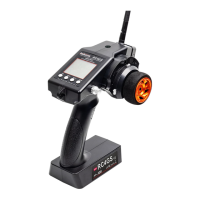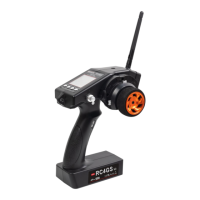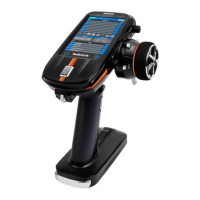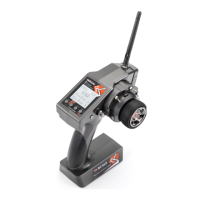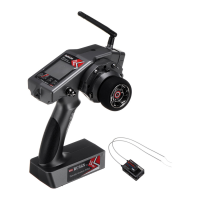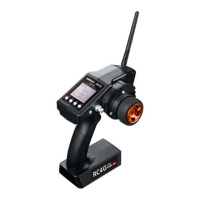Do you have a question about the RadioLink RC4GSV3 and is the answer not in the manual?
Detailed breakdown of the physical components and controls of the RC4GS V3 transmitter.
Explains the function and customization options for each switch and button on the transmitter.
Technical details including size, channels, range, power, and compatible receivers.
Step-by-step guide on powering on, navigating menus, and adjusting parameters on the transmitter.
Introduction to the R6FG receiver, highlighting its channels, gyro, and high voltage support.
Technical details for the R6FG receiver, including size, operating voltage, and signal type.
Instructions on how to bind the R6FG receiver to the RC4GS V3 transmitter.
Important safety and handling guidelines for the R6FG receiver and its antenna.
Explanation of the normal and gyro working modes for the R6FG receiver.
Viewing current servo output values for channels 1-5 on the transmitter.
Option to switch the transmitter menu language between English and Chinese.
How to select, manage, and name model memories for up to 30 different models.
Adjusting the maximum servo travel for steering, throttle, and auxiliary channels.
Modifying steering sensitivity around the neutral and end points without affecting max travel.
Reducing momentary under-steering or spinning during quick steering inputs.
Adjusting throttle servo response speed for forward and brake directions.
Delaying throttle servo operation to prevent wheel spin on slippery surfaces.
Pulse braking feature to eliminate under-steer during cornering and improve control.
Adjusting the initial throttle response for a quicker or smoother jump from neutral.
Raising engine idle speed for improved starting characteristics.
Setting a locked throttle value that overrides trigger position.
Fine-tuning the neutral position for steering, throttle, and auxiliary channels.
Reversing the operation direction of servos for steering, throttle, and auxiliary channels.
Reducing servo travel amounts for steering and throttle simultaneously.
Adjusting brake effect strength for weak or strong braking conditions.
Applying mixing between arbitrary channels for advanced control setups.
Customizing auxiliary channels (3-5) to control switches.
Renaming stored model memories for better organization.
Configuring low voltage and RSSI alarms for transmitter, receiver, and vehicle battery.
Understanding alarm indicators for transmitter, receiver, vehicle battery, and RSSI.
Setting gyro sensitivity and enabling/disabling gyro function via MIX settings.
Setting servo output values for each channel when the receiver loses control.
Selecting a specific receiver for control when multiple receivers are paired.
Using UP/DOWN timers for game timing and training, including alarm and lap functions.
Resetting all model memory data to original factory defaults.
Detailed breakdown of the physical components and controls of the RC4GS V3 transmitter.
Explains the function and customization options for each switch and button on the transmitter.
Technical details including size, channels, range, power, and compatible receivers.
Step-by-step guide on powering on, navigating menus, and adjusting parameters on the transmitter.
Introduction to the R6FG receiver, highlighting its channels, gyro, and high voltage support.
Technical details for the R6FG receiver, including size, operating voltage, and signal type.
Instructions on how to bind the R6FG receiver to the RC4GS V3 transmitter.
Important safety and handling guidelines for the R6FG receiver and its antenna.
Explanation of the normal and gyro working modes for the R6FG receiver.
Viewing current servo output values for channels 1-5 on the transmitter.
Option to switch the transmitter menu language between English and Chinese.
How to select, manage, and name model memories for up to 30 different models.
Adjusting the maximum servo travel for steering, throttle, and auxiliary channels.
Modifying steering sensitivity around the neutral and end points without affecting max travel.
Reducing momentary under-steering or spinning during quick steering inputs.
Adjusting throttle servo response speed for forward and brake directions.
Delaying throttle servo operation to prevent wheel spin on slippery surfaces.
Pulse braking feature to eliminate under-steer during cornering and improve control.
Adjusting the initial throttle response for a quicker or smoother jump from neutral.
Raising engine idle speed for improved starting characteristics.
Setting a locked throttle value that overrides trigger position.
Fine-tuning the neutral position for steering, throttle, and auxiliary channels.
Reversing the operation direction of servos for steering, throttle, and auxiliary channels.
Reducing servo travel amounts for steering and throttle simultaneously.
Adjusting brake effect strength for weak or strong braking conditions.
Applying mixing between arbitrary channels for advanced control setups.
Customizing auxiliary channels (3-5) to control switches.
Renaming stored model memories for better organization.
Configuring low voltage and RSSI alarms for transmitter, receiver, and vehicle battery.
Understanding alarm indicators for transmitter, receiver, vehicle battery, and RSSI.
Setting gyro sensitivity and enabling/disabling gyro function via MIX settings.
Setting servo output values for each channel when the receiver loses control.
Selecting a specific receiver for control when multiple receivers are paired.
Using UP/DOWN timers for game timing and training, including alarm and lap functions.
Resetting all model memory data to original factory defaults.
| Brand | RadioLink |
|---|---|
| Model | RC4GSV3 |
| Category | Remote Control |
| Language | English |
